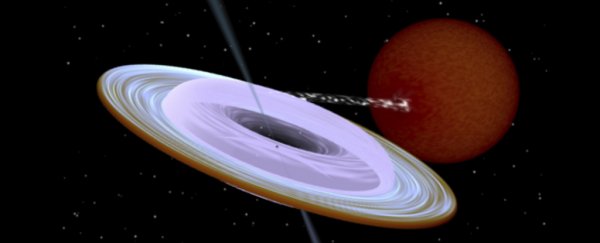Black holes could make a strong case for being the most fascinating phenomena in the whole Universe, and scientists are constantly discovering more about the way that they work and behave – including how they're created in the first place.
Now, a new study of an unusually misaligned one some 10,000 light-years away from Earth offers an example that challenges the established understanding of how black holes form.
The angle of this particular black hole, in the MAXI J1820+070 system, suggests that there are forces that we have yet to account for when black holes first come into being, forces that put this particular black hole way off-kilter with the system around it.
MAXI J1820+070 is an X-ray binary system, which means that it has a star and a black hole rotating around each other. Ordinarily, their rotational axes would be aligned and perpendicular to the orbital plane.
Not so with MAXI J1820+070. Researchers found that the spin axis of the black hole was angled away from the system's orbital plane by at least 40 degrees. That's surprising since these angles should match, or almost match, in the majority of scenarios.
The models that astronomers use to measure and assess black holes are based on the alignment across the rotational axis being level. If that's not the case in certain systems, our thinking about black holes needs to be adjusted, and other readings might have to be recalculated.
"Our results demonstrate the need to treat the misalignment angle as a free parameter when measuring black hole masses and spins," write the researchers in their published paper.
Researchers used optical polarimetric observations to take the readings, measurements of the optical and X-ray radiation coming off the accretion disk, the swirling matter that gathers around the black hole as it strips mass away from its companion star.
 Artist impression of the MAXI J1820+070 system. (Patat et al., Science, 2022)
Artist impression of the MAXI J1820+070 system. (Patat et al., Science, 2022)
That this 40-degree reading is so crooked suggests that something has happened in the very beginning of the black hole's creation, before the system has had a chance to right itself. In other words, it's likely to be something to do with the formation process, although the researchers aren't sure yet.
It's already thought that black holes get what are called natal kicks when they are created from giant stellar explosions, kicks which can sometimes break the system apart. It now seems that the same kick could create a misaligned black hole, or that something else is happening in the formation process that we haven't previously considered.
This idea that black hole alignment could be wonkier than we thought has actually been proposed before, but the black hole in MAXI J1820+070 offers more evidence and a direct reading of just how out of line the black hole could be.
Astronomers Ferdinando Patat from the European Southern Observatory and Michela Mapelli from the University of Padova in Italy were not involved in the new study but have written a commentary on it.
"[The study] deeply challenges the current understanding of how black holes can be formed and indicates the presence of a powerful kick produced by the supernova that generated the black hole," write Patat and Mapelli.
The research has been published in Science.
